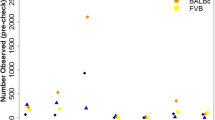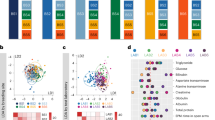Abstract
THE relative phenotypic variability of inbred and commercially available outbred stock mice has never been satisfactorily investigated, even though it has important implications in the design of animal experiments. Early workers1 suggested that “the published facts suggest that inbred strains are usually more variable than inter-strain hybrids, with random bred colonies occupying an intermediate position.” Later it was concluded that with respect to phenotypic variability, “no general law can be asserted on the comparison of inbred strains with randombred stocks”2. A subsequent debate on the suitability of inbred, outbred and F1 hybrid mice for biological assay3–6 failed to clarify the situation, and many research workers were left with the impression that inbred animals are more variable than outbred ones. Much of the early work could be criticised on the grounds that sample sizes were small, and few populations were sampled. We have collected extensive data on the phenotypic variability of the shape of the mandible, as part of a routine genetic quality control programme7,8, and have found that assuming equal sensitivity to an experimental treatment 50% more outbred than inbred mice would be required to detect a 1-unit change in mandible shape.
This is a preview of subscription content, access via your institution
Access options
Subscribe to this journal
Receive 51 print issues and online access
$199.00 per year
only $3.90 per issue
Buy this article
- Purchase on Springer Link
- Instant access to full article PDF
Prices may be subject to local taxes which are calculated during checkout
Similar content being viewed by others

References
McLaren, A., and Michie, D., J. Genet., 54, 440–445 (1956).
Biggers, J. D., McLaren, A., and Michie, D., Nature, 182, 77–90 (1958).
Chai, C. K., Nature, 185, 514–518 (1960).
Biggers, J. D., McLaren, A., and Michie, D., Nature, 190, 891–892 (1961).
McLaren, A., and Michie, D., Nature, 190, 894 (1961).
Becker, W. A., Nature, 193, 1264–1266 (1962).
Festing, M. F. W., Lab. Anim., 8, 265–270 (1974).
Festing, M. F. W., Lab. Anim., 8, 291–299 (1974).
Festing, M. F. W., Nature, 238, 351–352 (1972).
Falconer, D. S., Introduction to Quantitative Genetics, chs. 8 and 15, and p. 95 (Oliver and Boyd, Edinburgh, 1960).
Festing, M. F. W., Food and Cosmetics Toxicology, 13, 369–375 (1975).
Author information
Authors and Affiliations
Rights and permissions
About this article
Cite this article
FESTING, M. Phenotypic variability of inbred and outbred mice. Nature 263, 230–232 (1976). https://doi.org/10.1038/263230a0
Received:
Accepted:
Published:
Issue Date:
DOI: https://doi.org/10.1038/263230a0
This article is cited by
-
Production and verification of a 2nd generation clonal group of Japanese flounder, Paralichthys olivaceus
Scientific Reports (2016)
-
Morbidity and mortality rates associated with serial bleeding from the superficial temporal vein in mice
Lab Animal (2010)
-
Genetic variance of laboratory outbred Swiss mice
Nature (1980)
Comments
By submitting a comment you agree to abide by our Terms and Community Guidelines. If you find something abusive or that does not comply with our terms or guidelines please flag it as inappropriate.


